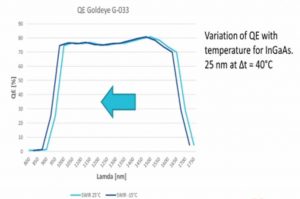Temperature Control is Crucial
Influence of Temperature on Image Quality in NIR-/SWIR
Most SWIR camera sensors are based on InGaAs material and work like silicon-based CCD or CMOS sensors by converting photons into electrons – so called quantum detectors. InGaAs sensors are made of Indium, Gallium, Arsenide based photodiodes and silicon-based read-out integrated circuits (ROIC). The band gap energy is typically smaller in InGaAs photodiodes than in silicon based pixels. As a result, the dark current is higher at similar temperatures.

Figure 1 | The influence of temperature on image quality in NIR-/SWIR cameras (gain 0 to 100ms exposure time): at 20°C (left, with Goldeye CL-033 TEC1 camera) and … (Figure: Allied Vision Technologies GmbH)

… 45°C (right, with Goldeye CL-033 TECless camera) sensor temperature. (Bild: Allied Vision Technologies GmbH)
Dark current is current that flows (for example produces a signal) even if no light is hitting the sensor. It is caused by thermal excitation of electrons in the InGaAs material. The absolute value of the dark current can vary considerably from one sensor to another. Dark current increases strongly with higher sensor temperature. As a rule of thumb, it doubles approximately every 9°C. For example, when the same picture is taken twice with the same camera at 20 and 45°C sensor temperature, the histograms show very different results. At 45°C sensor temperature the minimum value is higher (0 being black to 255 being white) as well as the average value. At 20°C there are no saturated pixels (max. value 254) whereas at 45°C there are quite a few.
Spectral sensitivity
Sensor temperature also has a high influence on the spectral sensitivity of SWIR cameras. When sensor temperature is lowered by 40°C (from 25 to
-15°C) it results in a shift of the spectral sensitivity of about 25nm towards lower wavelengths. This might be of great importance for applications operating at the low or high end of the sensitivity curve. When sensitivity above 1.700nm is required, sensor temperature should not be too low (which means below 20°C). Even though dark current (and noise) increase with higher temperature, the signal might still be better at the higher end of the spectrum.

Figure 2 | When sensor temperature is lowered from 25 to -15°C it results in a shift of the spectral sensitivity of about 25nm towards lower wavelengths. (Figure: Allied Vision Technologies GmbH)
Sensor temperature control
The temperature level influences the spectral sensitivity and the dark current. The dark current has a high impact on image quality (black level and noise). For applications where image quality is important and when operating at the low or high end of the sensitivity curve, temperature control is crucial. To accurately monitor and control the temperature, all SWIR Goldeye cameras implement three temperature sensors (one inside the InGaAs sensor housing, one on the sensor board and one on the mainboard). In addition, the cameras provide advanced features to correct and minimize those effects (for example advanced background correction). To counterbalance the temperature difference between ambient and sensor temperature and to stabilize the set sensor temperature, most of the Goldeye camera are equipped with a thermo-electric cooling device (Single-/dual-stage-thermo-electric sensor cooling or additional cooling fan). In addition, the Goldeye Cool models enclose the sensor in a Nitrogen filled cooling chamber. That protects it from condensation and makes it suitable in environments where condensation is likely to occur (that is high humidity, high ambient temperatures).












